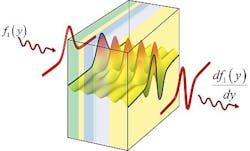
The latest ingenious twist on metamaterials is using them for analog computing on light waves. It's an extension on the concept of transformation optics, with the transformation being a mathematical operation on a light wave passing through the metamaterial. In a paper just out in Science, a group led by Nader Engheta of the University of Pennsylvania (Philadelphia, PA) proposes "computational metamaterials" that perform a variety of mathematical operations on light.
If you've got a bit of gray hair, this may ring a bell. Remember optical signal processing? Developed by Emmett Leith and colleagues in the mid-1950s at what was then the University of Michigan's Willow Run Laboratory (Ann Arbor, MI), it used bulk optics to convert raw data collected from the air by synthetic aperture radar into images of terrain and buildings. The technology was such a brilliant success that the Pentagon kept it classified for years. Development of other types of optical processing continued for decades, largely in military programs to automate object recognition.Optical processing arguably may have been the last triumph of analog computing, which performed mathematical operations by manipulating mechanical or electrical analogs of the quantities being computed. The slide rule was one simple example, widely used by engineers and scientists before digital calculators and computers became widely available. But as digital computers became more powerful, they eventually replaced optical processing as well as the slide rule and other analog computers. Digital signal processors now compensate for chromatic and polarization-mode dispersion in fiber-optic systems.
Enghata is a veteran of the old optical-processing days, and his group proposed metamaterials as a new technology to revive optical processing. They envision two approaches: One sandwiches a metasurface between a pair of GRIN structures to perform mathematical operations in the Fourier domain, and the other uses a multilayered metamaterial structure to perform the operations. Both structures "are smaller than conventional lens-based optical signal-processing systems by several orders of magnitude," they write in Science, adding that such designs might "lead to direct, ultrafast, and wave-based analog computation, equation solving, and signal processing at the hardware level."
Today's digital signal processors are so cheap and so powerful that they will pose tough competition. But like replacing vacuum tubes with integrated circuits, computational metamaterials are likely to open new opportunities that were impractical with present technology. It will be interesting to watch.
However, it was discouraging to read the university's press release, which rambles on at great length about mechanical and electrical analog computing, but completely ignores the past importance of analog optical processing. Like claiming integrated electronic computers immediately followed mechanical calculators, it misrepresents the real path of progress.
About the Author
Jeff Hecht
Contributing Editor
Jeff Hecht is a regular contributing editor to Laser Focus World and has been covering the laser industry for 35 years. A prolific book author, Jeff's published works include “Understanding Fiber Optics,” “Understanding Lasers,” “The Laser Guidebook,” and “Beam Weapons: The Next Arms Race.” He also has written books on the histories of lasers and fiber optics, including “City of Light: The Story of Fiber Optics,” and “Beam: The Race to Make the Laser.” Find out more at jeffhecht.com.

